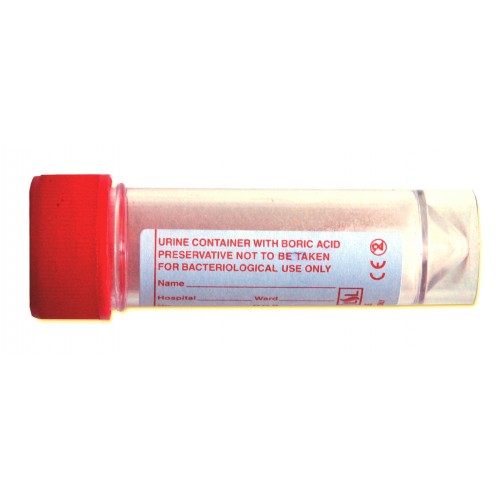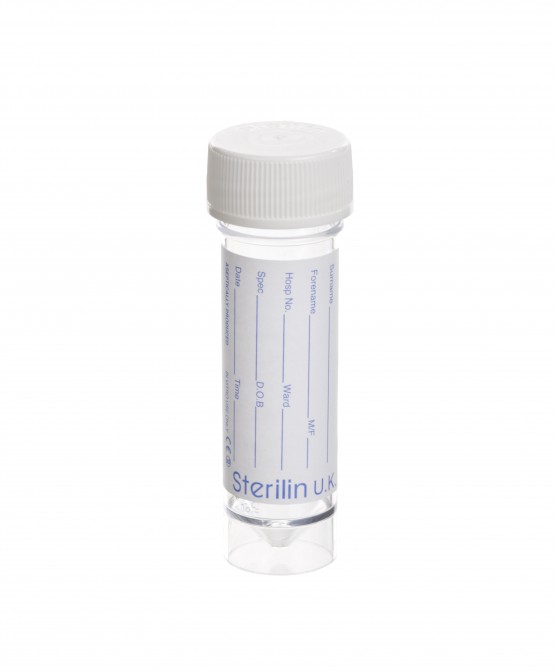Urine samples must be sent in boric acid container unless the patient is under 3 years old. Samples from patient under 3 should be collected in a white topped bottle, and sent to the laboratory as soon as possible.


Mid Stream Urine (MSU)
The presence of colonising bacteria from the external genitalia may give rise to a misleading culture result; therefore it is essential that a clean mid-stream specimen of urine is obtained using the following protocol.
- Mid-stream urine packs are available on request from the C.S.S.D. and should be used.
- To cleanse the external genitalia use tap water or sterile saline and NOT antiseptic. The prepuce must be retracted in the male and the labia separated in the female.
- The first part of the urine stream should be discarded and the mid-stream specimen passed into a sterile urine specimen container or other sterile receiver.
- Empty this specimen into the boric acid urine container, which should be filled to the line.
Clean-Catch Urine
This is an unsatisfactory specimen and is not recommended.
Suprapubic Aspirate (SPA)
Urine is obtained aseptically, directly from the bladder by aspiration with a needle and syringe. The use of this invasive procedure is usually reserved for clarification of equivocal results from voided urine (e.g. in infants and small children).
Catheter Urine (CSU)
May be:
- “acute”, obtained a newly catheterised patient (Cath – urethral)
- intermittent self-catheterisation (Cath – self), or
- from a long term indwelling catheter (Cath – indwelling)
In the latter, the specimen is obtained aseptically from a sample port in the catheter tubing or by aseptic aspiration of the tubing. The specimen should not be obtained from the collection bag. NB. Protein, leucocytes, red cells and organisms are commonly found in the long-term catheterised patient. These may be found on dipstix testing but are not abnormal in the absence of systemic symptoms of sepsis. Catheter urine specimens should not be sent on a routine basis or in asymptomatic patients unless manipulation of the catheter is planned.
Bag Urine
Used commonly for infants and young children. This is not a recommended specimen. The sterile bags are taped over the freshly cleaned and dried genitalia, and the collected urine is transferred to a sterile container.
Pad Urine
An alternative collection method to bag urine for infants and young children. This is not a recommended specimen. After washing the nappy area thoroughly, a pad is placed inside the nappy. As soon as the pad is wet with urine (but no faecal soiling), push the tip of a syringe into the pad and draw urine into the syringe. Transfer specimen to a sterile urine container.
Ileal Conduit – Urostomy Urine
Urine sample is obtained via a catheter passed aseptically into the stomal opening after removal of the external appliance. Results from this type of specimen may be difficult to interpret.
Cystoscopy Urine
Urine sample is obtained directly from the bladder using a cystoscope.
Ureteric Urine
Paired urine samples are obtained from each ureter during cystoscopy via ureteric catheters inserted from the bladder. Urines may also be sent following nephrostomy, surgery or bladder washout.
Localisation culture for diagnosis of prostatitis (Stamey’s Test)
These specimens are usually taken in urology and GUM. The following specimens are collected:
- the initial 5-8ml voided urine (urethral urine)
- MSU (bladder urine)
- expressed prostatic secretions following prostatic massage
- the first 2-3ml voided urine following prostatic massage
Early Morning Urines
Three entire, first voided early morning urines are required for culture for M. tuberculosis. These specimens should only be taken after the results of MSU have demonstrated presence sterile pyuria.
Urine for Schistosoma Haematobium
Total urine sample collected between 10:00-14:00hr in to a sterile containers without boric acid preservative is required. Alternatively a 24hr collection of terminal urine may be examined. These specimens should not be collected until 3 months after last exposure unless there are clinical symptoms suggestive of Schistosomiasis. A MSU for microscopy should be collected before undertaking this investigation.

